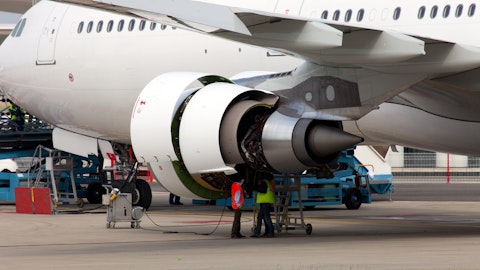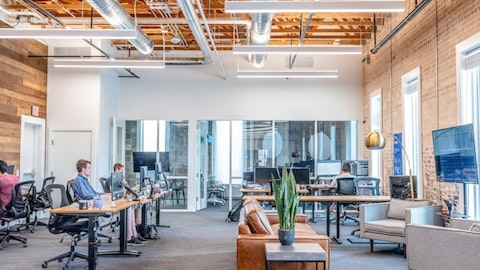Scott Deuschle: Thanks, guys. Incredible quarter.
Chip Blankenship: Yeah. Thanks.
Bill Lacey: Thank you.
Operator: Your next question comes from the line of Matt Akers from Wells Fargo. Please state your question.
Matt Akers: Yeah. Hey, guys. Good afternoon. Thanks for the question.
Chip Blankenship: Good afternoon, Matt.
Matt Akers: Hey, Bill, you made a comment in the opening remarks about I think it was kind of pressure on margins from kind of mix of cost versus price increases to the rest of year. Could you just elaborate on that a little bit and maybe the timing? And I think in prior years, you’ve gotten kind of a January 1 pricing step up. Is that kind of still the right way to think about it for this year?
Bill Lacey: Yeah. I believe the discussion, Matt, that I was having was as it relates to our Q1 margin delivery of 20.5% in Industrial. And the pressure against the Q1, it’s really on the ongoing standpoint, it’s in-line with what we anticipated. So, it’s more versus that Q1 experience. And as we look in Industrial, we don’t expect this year to have a 20.5% rate — overall margin rate. And as I mentioned in our non-OH business where we talked about it delivering about 900 basis points that really was us having a very strong mixed quarter in Q1, and we don’t expect that to continue. And secondly, we anticipate some cost coming into play in Q2 to Q4, which again will not allow us to repeat that 20.5%. Now, we are aspiring and working hard in our investments and all of our initiatives to get to that underlying non-OH margin rate, but again that’s going to be more out in the future and not here in fiscal year 2024.
Matt Akers: Got it. Thank you. That’s helpful. And then, I guess, if I could one more, just the timing you’re thinking of this new repurchase authorization, is that kind of a two-year period like the last one was, or just how you’re thinking about that?
Bill Lacey: Yeah. So, what we announced, Matt, was a three-year program, $600 million in total, and our philosophy on that is to manage dilution. And also, as we look at our cash flow and as we look for the highest return opportunity, we will continue to consider further purchases. But that’s right, the plan that we submitted was a three year $600 million program.
Matt Akers: Great. Thank you.
Chip Blankenship: You’re welcome.
Operator: Your next question comes from the line of Sheila Kahyaoglu from Jefferies. Please state your question.
Sheila Kahyaoglu: Thanks, guys. Good afternoon. I just wanted to follow on Industrial and check in on long-term margin. You talked about mixed pressures and when you look at Q1 margins ex CMG, it looks like 15% and then probably for the rest of the year 12%. So, is it right way to think about your longer-term margins come to 12% or 15% as your target state? Just thinking about beyond ’24 into ’25, is the 300 bps all cost pressure?
Bill Lacey: Yeah. Again, the original guidance that we gave on our business was 13% to 14% for that Industrial business and sort of the mid-15%s. And as we look longer-term, Sheila, we’re still sort of in that mid-teen range for Industrial.
Sheila Kahyaoglu: Okay. And then similarly on Aerospace, if we could talk about profitability there? Just up nicely year-on-year, but work to do to get to the guide. So, how do we think about that progressing through the year, especially in light of some of those early comments, the productivity you guys have in place and the price capture?
Bill Lacey: Yeah. As you mentioned, Sheila, we saw a nice 300 basis points improvement versus Q1 a year ago. As we discussed at Investor Day, the margin rate increase that you’ll see in Aero is mainly driven by volume in our OEM business. As we mentioned, the OEM growth outpacing the aftermarket growth will cause a mix pressure at our [CM] (ph) level, but as that volume comes through, we’ll get leverage and we’ll see that increase. As Chip mentioned, we understand what we understand as it relates to the Boeing announcement. And based on what we understand right now, our confirmation of our 18% to 19% Aero is still good and we will keep monitoring. And if something changes, we will communicate that, but really that volume increase throughout the year being levered is what will get us to higher margin rates.
Sheila Kahyaoglu: And is the defense aftermarket accretive or dilutive to segment Aero margins?
Bill Lacey: Yeah. Our defense aftermarket is good margins. We’ll take it all day.
Chip Blankenship: It’s accretive, yes.
Sheila Kahyaoglu: Okay. Thank you.
Chip Blankenship: You’re welcome.
Operator: Your next question comes from the line of Gavin Parsons from UBS. Please state your question.
Gavin Parsons: Thanks. Good afternoon.
Chip Blankenship: Good afternoon.
Bill Lacey: Hey, Gavin.
Gavin Parsons: Guys, how much visibility you have into the other industrial businesses besides OH in terms of revenue?
Chip Blankenship: So, we have some really close long-term forecast work that we do with our customers in areas where we can freeze volumes and understand what the expectations are from customers, whether that is in the gas turbine arena or the reciprocating engine arena and across all three of our sub-segments for that Industrial segment. So, pretty good visibility and pretty good stability and we continue to burn down past dues as well internally. So, we’re getting closer to the customer demand directly affecting our — what we plan for in our factories.
Gavin Parsons: Was Industrial backlog up for the quarter?
Chip Blankenship: We don’t really measure it that way and we talked about that on another conference call. We have a way of looking at that, but because we are building to a forecast as well as their actual orders, when the orders come in sometimes, that doesn’t exactly represent what we’ve built.
Gavin Parsons: Makes sense. And then maybe if I just go back to the Investor Day slide showing the engine service value 5 times higher on this generation of engine which is greater than your content gains. Can you just remind us when the majority of your engine aftermarket occurs and kind of how that’s spread over regular service versus heavy checks?
Chip Blankenship: So, we still — we forecast the 2026 long-term view that we shared at Investor Day is that 2026 is before some of that really I think volume of the aftermarket shows up on the engine side. So, the guide for Aerospace margins and all of our cash flow and the like really is before the wave of that engine aftermarket that we expect from the GTF and the LEAP engines on the 737 MAX and the A320 Neos. So, there’s a lot of goodness outside that forecast that we’ve already given.
Gavin Parsons: Thank you.
Operator: Your next question comes from the line of Pete Skibitski from Alembic Global. Please state your question.
Pete Skibitski: Yeah, good afternoon, guys. Nice quarter.
Chip Blankenship: Hey, Pete, thank you.
Pete Skibitski: On the $75 million of China on-highway, I recall you guys were expecting closer to $50 million in the quarter. Could you maybe validate that? And then now you’re expecting $50 million in the second quarter. And I just wanted to get maybe a little more fidelity on the back half of the year when you talk about minimal activity. Is that closer to zero or is that closer to kind of a $25 million to $50 million range? I just wanted to get more fidelity there.



